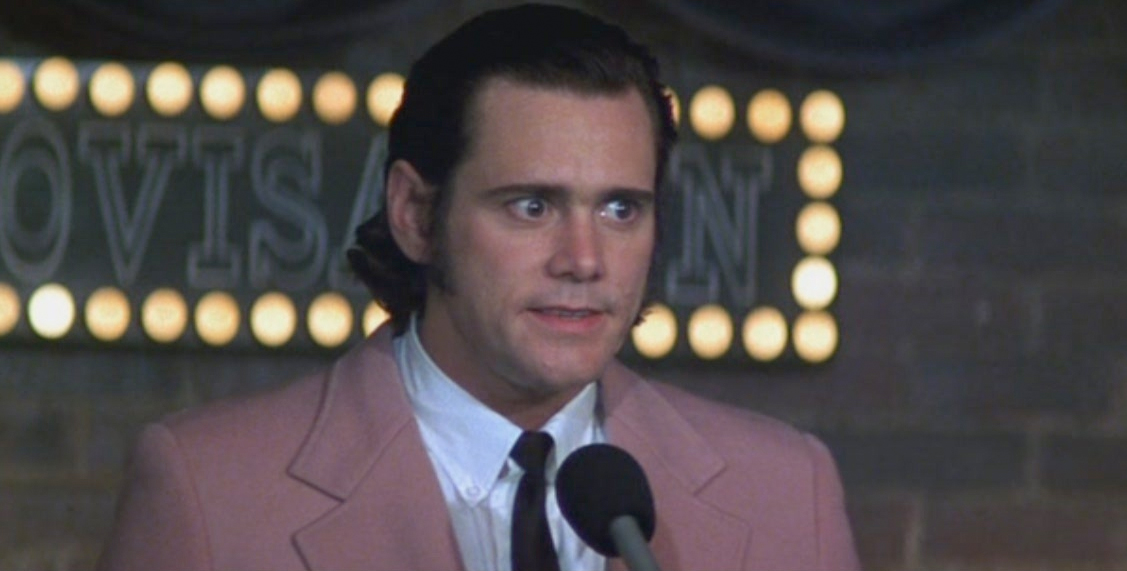Famous Dead Comedian Returns to Bewilder Audiences via Blu-ray
DIRECTED BY MILOŠ FORMAN/1999
BLU-RAY STREET DATE: FEBRUARY 22, 2022/KL STUDIO CLASSICS
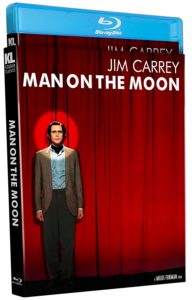
Andy Kaufman: deranged prankster or the most successful performance artist of all time? The answer, or course, is yes.
Anarchic in its deliberate aloofness and simultaneously venerating and condemning its subject, the question emerges…. are we supposed to laugh at Man on the Moon? It stars Jim Carrey at the height of his powers. It is a studio biopic of unpeggable performer Andy Kaufman, considered by many to be a comedy genius. It is not unfunny. Yet, it’s more uneasy than humorous.
Such unease, however, is mostly to the film’s credit. Man on the Moon is a special movie insofar as it aspires to operate in the same kind of blurred reality that Kaufman cultivated. Sometimes it slips into sentimental mode, but more often than not, its devotion to keeping us on our toes wins out. We can’t hope to keep up with it, as there are no tells as to where it will go next. Even aficionados of Kaufman must pay close attention.
Scott Alexander and Larry Karaszewski (the writing duo behind Ed Wood and Dolemite is My Name) re-team with prestige director Miloš Forman (One Flew Over the Cuckoo’s Nest; Amadeus) to tell this untethered and often tragic tale. Look closely and you might just catch a glimpse of them vying for the roles of the business’s foremost mainstream intellectual movie mischief makers circa Y2K.
Though Man on the Moon is a project of lesser extremes but far more bewilderment, the mutual creativity of Karaszewski/Alexander/Forman clicks with a certain quantified ease. Having previously worked together on the prestigious story of a deeply questionable individual with The People vs. Larry Flynt, the powerful triumvirate is unquestionably in the zone here. (It would be up to Jim Carrey, claiming to have literally been overtaken by the spirit of Kaufman, to seriously disrupt the flow). Their natural preference for forsaking a more conventional narrative in favor of vignettes stitched together in the shape of a story is never internally challenged. This too is mostly to Man on the Moon’s individual credit. Somehow, this greased showbiz pig of a patchwork adds up to a full story. Or at least, a fuller story.
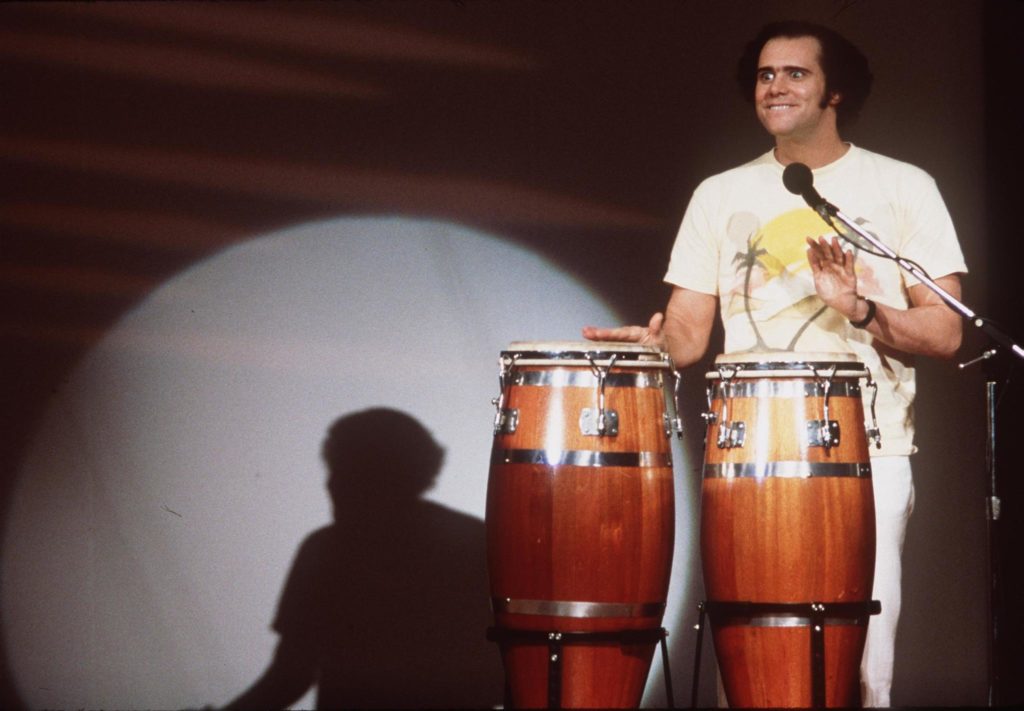
That story goes a little something like this: One scene of Andy Kaufman as a weird kid. Cut to him getting his unlikely showbiz start. Kaufman becomes a TV presence and an infamous disrupter, an icon of “more weird than funny” comedy. His obnoxious alter ego Tony Clifton (also played by Kaufman co-conspirator Bob Zmuda, who is played here by Paul Giamatti) unleashes uncomfortable mayhem. He transitions into a “bad guy wrestler” who challenges, and wrestles provoked female audience members in the ring. Kaufman throws the show of his life at Carnegie Hall. He gets sick and dies.
But first, it starts with a cheeky direct address to us, the viewers. Everyone refers to Adam McKay’s running of the credits midway through Vice as some sort of brazen touchstone. We all plum forgot that back in 1999, Miloš Forman had the audacity to run them merely a minute or so into Man on the Moon. The film begins with Jim Carrey as Kaufman speaking to the camera, in black and white and seemingly outside of time. The movie is stupid, he says. So, he did us a favor, and cut out all the baloney! Consequently, that’s it. Roll credits!
Of course, though, that’s not it. After a truly admirably long hold of black screen, we do get a movie proper. “Proper” in form, anyhow. In terms of casting, lines blur all over the place. When it comes time to represent Kaufman’s famous role as Latka Gravas on the TV series Taxi, most of the actual cast members (including Christopher Lloyd, Carol Kane, Marilu Henner, Judd Hirsch, and Jeff Conaway) appear as themselves, although not in de-aging makeup. Conspicuously absent in the Taxi sequences is Danny DeVito, but only because he’s playing the prominent role of Kaufman’s manager, George Shapiro. Although DeVito bears little resemblance to Shapiro, his portrayal resonates as the heart of the otherwise rather cool-to-the-touch film. When Kaufman informs his inner circle of his fatal cancer diagnosis, it’s DeVito’s crestfallen response that drives the moment home.
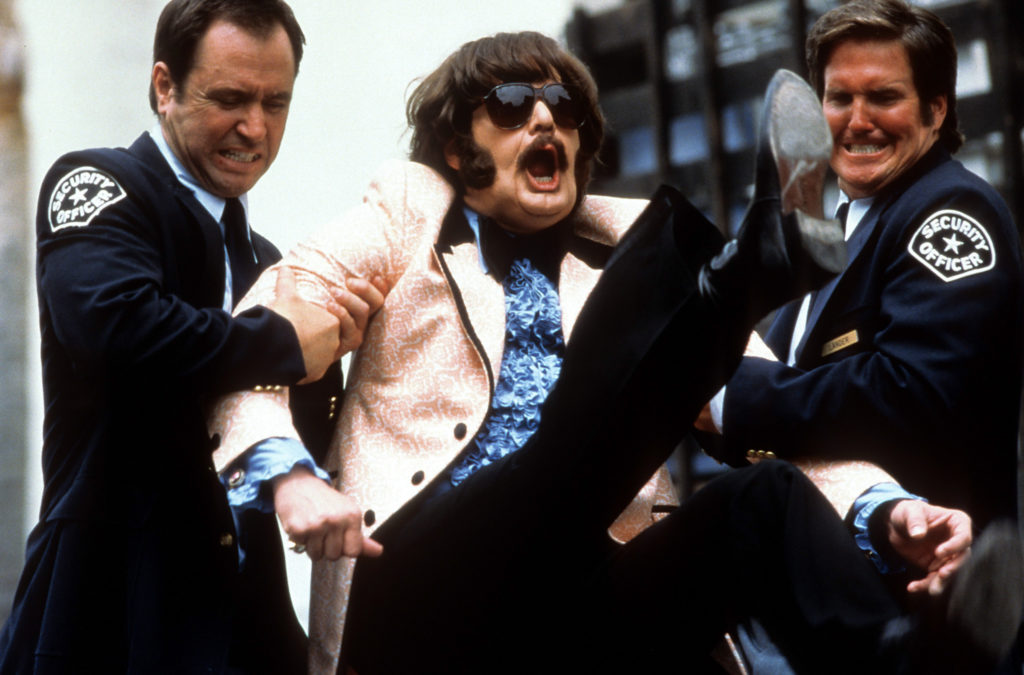
DeVito, it must be mentioned, is also a producer of the film. Ostensibly, he’s the one who got this movie made. He’s also a veteran of Miloš Forman’s cinema, having appeared in Cuckoo’s Nest years earlier. Other Forman favorites also turn up throughout the film, including Courtney Love as Kaufman’s girlfriend Lynne Margulies and Vincent Schiavelli as a perpetually flustered ABC network executive. Late ‘70s/early ‘80s talk show sets and sketch comedy show sets are recreated to host restagings of some of Kaufman’s most notorious appearances.
The movie-averse David Letterman plays himself in a recreation of Kaufman’s on-air botched bury-the-hatchet meeting with wrestler Jerry Lawler. It’s the denouement following this scene when Man on the Moon itself reveals the truth of the Kaufman/Lawler feud; something of a fun shock. Though Lawler, also playing himself, looked much the same in ‘99 as he did when the craziness really went down, Letterman absolutely does not. In true Letterman style, he refused to wear any wigs or alter his appearance in any way. Lorne Michaels of SNL fame splits the difference in his self-portrayals, coloring his hair for the redo of Kaufman’s “Mighty Mouse” bit on his show’s premiere episode, but appearing contemporary for a later bit, announcing that viewers could vote Kaufman off the show. (That moment didn’t actually involve Michaels at all, as it occurred during his five-year hiatus from SNL).
Man on the Moon seems to be of the opinion that Kaufman became famous and also stayed famous in spite of himself. While his constant boundary-pushing is celebrated, there is a tendency to treat those he trounced in his wake as collateral damage. Carrey himself appears to maintain that same attitude regarding his performance process, which is documented in the 2017 Netflix documentary Jim & Andy: The Great Beyond. In that film, Carrey claims that he was overtaken by “the spirit of Andy Kaufman”, and that he himself was a helpless if awestruck backseat driver. He made the production its own kind of unnecessary hell for everyone involved while embodying the dead subject in a truly uncanny way. It’s a bunch of infuriating jackassery, yes, but the film, fortunately, emerges as rather good. Forman’s touch reigns it in, his perseverance a testament to the truth that it’s people like Kaufman who make the world an interesting place. Likewise for Man on the Moon.
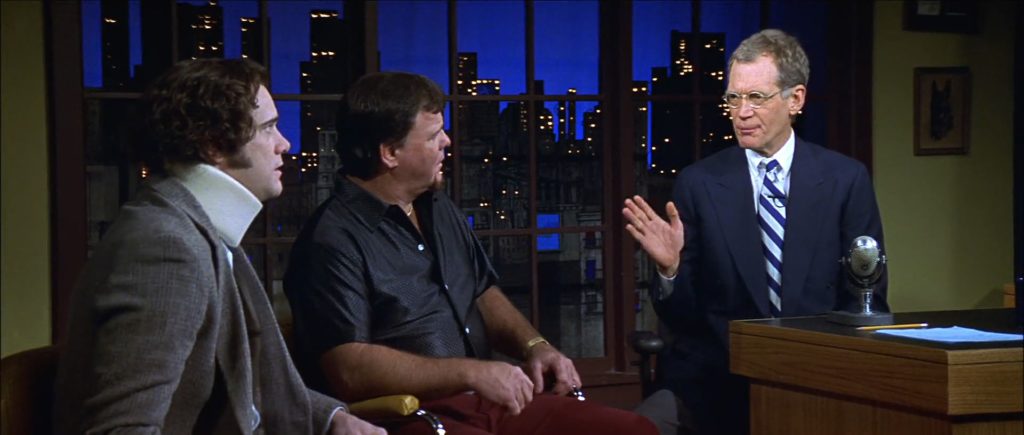
R.E.M.’s great and cryptic early ‘90s earworm eulogy, also the film’s namesake, turns up several times- both as itself and in orchestral form. R.E.M., still considered one of the top bands on all the land in 1999, though beginning to wane by then, also provide a proprietary track called “The Great Beyond”. It too is reworked orchestrally and also featured in full in the closing credits. It’s a pretty good but not great song. Alongside of the ubiquitous “Man on the Moon”, it cannot ever measure up.
Film historian Howard S. Berger has gone above and beyond for the bonus features on this special edition disc. Not only does he moderate the new audio commentary track featuring screenwriters Alexander and Karaszewski, but he has also assembled a twenty-or-so-minute-long piece called “This Might be a Story”. Using a micro-cassette recording provided by the writers of a post-production talk with Forman, Berger has whittled the exchange down to highlights, and set it to a corresponding slide show of Man on the Moon stills. Forman does most of the sharing, so this new fly-on-the-wall access to the late director is particularly valuable, as he never recorded a commentary proper for this film.
That said, some of Forman’s anecdotes repeat almost verbatim from the vintage EPK-style “Spotlight on Location: The Making of Man in the Moon” featurette. Like any such promotional piece, this one is all about accentuating the positive, even though outside evidence argues the opposite. Glaringly missing is any footage of the real Kaufman, something that even the less-stacked original DVD managed to incorporate (as part of its now antiquated clickable biographical essay. Click on Kaufman’s head for a corresponding clip!).
The centerpiece bonus feature of the new Blu-ray, however, is the newly recorded audio commentary with Alexander and Karaszewski. Moderated by Berger, this is a track that is both fun and insightful. In fact, the writers have enough insight to fill out the entire running time even without getting into detail on the Jim Carrey on-set shenanigans. If ever there was a commentary that lands as required listening in conjunction with its film, this is it. Much can obviously be said about Man on the Moon; here, we get it straight from its originators. The extras are rounded out with two R.E.M. music videos and twelve minutes worth of deleted scenes.
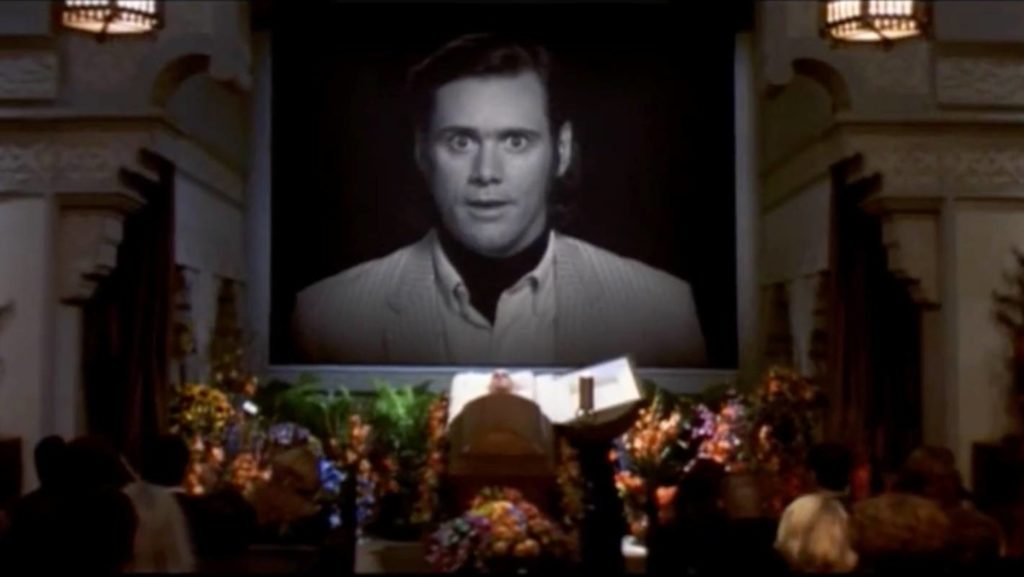
It’s too bad that Jim & Andy could not be included on this Blu-ray as an extra. Not much is made of Carrey’s real-life antics in the vintage extras, as the actor claimed that the studio didn’t want the public to think that he was “an asshole”. (Carrey’s on-camera explanations in Jim & Andy – itself interesting but almost fatally navel gazing – may or may not lead viewers to that conclusion anyhow). Carrey claims that Man on the Moon is a film about identity, not unlike the career of David Bowie. He’s not wrong, though one might add that it’s also about the consequences of a lack of identity.
The Blu-ray’s brand new 2K master, approved and color graded by cinematographer Anastas Michos, outstandingly communicates the story’s time period in a tactile, subtle manner. Whether Kaufman, playing children’s songs in comedy clubs and goofing on Elvis and insulting an entire gender and taking concert hall audiences out for milk and cookies, really was the invaluable anarchic genius that the film posits, it’s refreshing to experience a major motion picture throwing so much caution to the wind. We come away knowing no more about the inner-Kaufman than when we went in. And that’s fine. What we do get is what its trailer promises: “The man, the myth, the misunderstanding”.
The images used in the review are present only as a reference to the film and are not meant to reflect the actual image quality of the Blu-ray.


